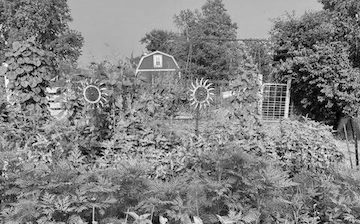Good fences aren’t always what make good neighbors

A month ago, my 87-year-old neighbor Donna had a stroke in my yard.
I was down on my hands and knees working in my garden. I glanced up to see Donna standing calmly above me. “We need to go to the emergency room,” Donna said, leaning on a cane, her leg stiff, the right side of her face drooping, her eye enlarging.
“You’re having a stroke. Get in the car right away!” I dashed into the house to grab my purse. Out my window, I could see the windmill repairman heading through Donna’s pasture gate, but I didn’t have time to deal with him. In minutes, we were speeding the 15 miles to the nearest hospital.
Donna and I, two English, or non-Amish women, have lived side-by-side in the middle of the Old Order Amish region for years. I moved into an old Amish schoolhouse in 1988, and fixed it up into a livable abode. The schoolhouse still held one lonely desk in the middle of the large room with layers of dust on the floor. There were two bathrooms, a boys’ and a girls’. I knocked down a wall, installed a shower, and created one restroom.
The schoolhouse had a long counter under the south windows. When I ran a sponge over the top of the counter, big chunks of linoleum came off in my hand. So, I ripped out the counter and installed a sink and cabinets. I went to the used appliance store and purchased an apartment-sized stove and refrigerator. Voila! I had a kitchen.
I began cooking meals, feeling right at home, except for one thing. The green house right next door. Here I was in the middle of nowhere, and I had another house butting up against me. There was an Amish phone booth in the garage of the house. Five or six families shared the phone there, and I loved the comings and goings this created.
My Amish neighbors pulled into my drive, hitching their horses to a couple of old T-Posts on my property. The Amish can use a phone but can’t have one in their house where it would inevitably ring whenever they sat down to a family dinner.
Harriet, the owner of the green house, didn’t care for the Amish and complained that they ran up her electricity bill through the one bare bulb that hung down from the ceiling in the tiny phone booth. Over the course of the year, there was a stand-off with Harriet scattering cinders and even some broken glass in her lane to prevent the Amish from using the phone.
“Darn it,” I said to myself one evening when I was doing my dishes. “Here I am in a beautiful neighborhood, except for that woman who lives in the green house. And the house is right next to me.”
Then after a year, a FOR SALE sign went up in front of the green house, and soon Donna and her husband Stu moved in. They painted the green house yellow. They cleaned up all the cinders and glass. They took an old flag pole down and made it into a hitching post, welcoming the Amish.
“Whoa, this was better,” I thought. My only complaint was the bright yard light that Stu installed. It ruined my stargazing, but I tried to let that go. I resisted the urge to shoot out the yard light bulb with the slingshot I kept on hand to drive away diseased cats and raccoons.
“When we moved into our house,” Donna told me years later. “I thought everything was perfect except for that old schoolhouse right next to us. And why would that woman be living in that old wreck of a building? I wish we could get rid of her.”
The day of her stroke, I stayed at the hospital with Donna, moving through various tests with her, an MRI, then a CAT scan, waiting for the neurologist to appear on a little TV screen beside her gurney. Finally, Donna was admitted to the hospital floor, and her son and daughter-in-law who had just gotten off work, stepped into the room.
Donna had been a city mouse, raising her family in an urban area until her five children were grown. Then she talked Stu into moving to the country. Once here, she quickly transformed into a country mouse, leaving her children to scatter to other cities in the U.S.
I drove home to grab a bite to eat, then crashed into bed. The next morning, I arose early, only to spy Donna’s two lambs wandering through her front yard, heading toward the road. Yup, the gate to the pasture was wide open, probably an oversight from the windmill repairman.
I shooed the lambs back into the pasture, and tried to close the gate, but the latch didn’t close securely. I found an old piece of wire and made a temporary repair. Then I saw that the gate didn’t fit against the adjoining pole. There was a gap wide enough for the lambs to wiggle through. I threaded a bungee cord through the gate and wrapped it around the pole, pulling it tight.
“There,” I thought. “That’s a bit of a girl fix, but it should hold until I can get help with this gate.”
A couple of hours later, the lambs were out again. This time, I watched them step right through Donna’s wooden gates. In the past, Donna had kept horses, and the wooden gates with their wide slats had always been enough to keep those animals contained. But after her divorce from Stu and the death of her favorite gelding, Donna decided to concentrate on more manageable critters.
But once again, the lambs, and Donna’s three high-stepping geese, went right through the wooden gates. This time, it took me a good couple of days to get the sheep and geese back where they belonged. The geese turned into versions of Daffy Duck, laughing at the barnyard dance. No handful of grain or hay would lure them. Off and on, for 48 hours, we do-si-doed, until the animals finally gave up.
Ding!
A text from Donna’s daughter-in-law.
We assume all is well and you are taking care of the animals.
I replied that I could use a little help with the gates out here. No help arrived. I covered the gates with some old pieces of cattle panel and more bungee cords.
Ding!
Can’t you just put the lambs in with yours?
I explained that I could bring Donna’s lambs to my place and blend them in with mine, but then I would have to mow Donna’s hilly 2-acre pasture.
Ding!
Why don’t you just put Donna’s lambs in her barn?
I could do that if I could get them to go in there. And it’s so hot … It would be best if we could just fix the gates properly. Then I would be happy to care for them until I could take them to slaughter in the fall.
Ding!
Slaughter??????
Oh, no, I thought, the city mice are vegetarians. These lambs aren’t pets, I explained. They are livestock.
Ding!
We are contacting the Humane Society to take the lambs.
Good grief, I said. That isn’t necessary.
I called my handywoman and got on her list. A month later, she arrived, and we worked for a whole day together, fixing the gates and latches with new screws, with hardware cloth and cattle panels.
Later that day, I visited Donna in the rehab unit and told her that everything was fine, don’t worry about the animals or the house. We had been good neighbors long enough that we knew how to support one another.
“I can’t thank you enough,” Donna said.
She paused then turned to me. “And why don’t you see if you can bring my lambs with yours to slaughter in the fall.”
——
Mary Swander is a well-published author and playwright, the executive director of AgArts, and the host of the “AgArts from Horse & Buggy Land” podcast. Find her work at maryswander.com. She is a member of the Iowa Writers’ Collaborative. Subscribe to her blog, Mary Swander’s Buggy Land,


